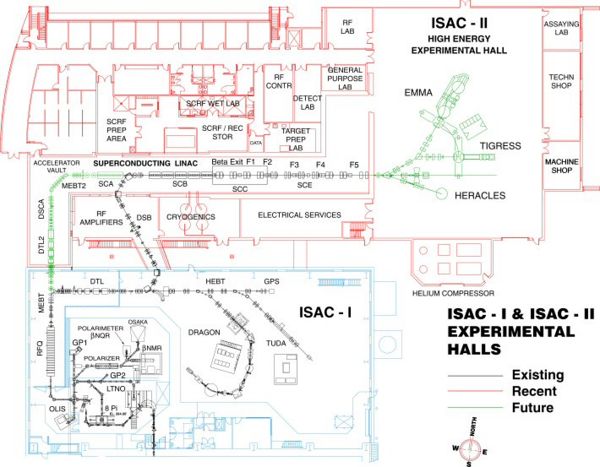TRIUMF: Guide for experimenters
|
The purpose of this site is to provide all the necessary information to allow a User to propose, plan, and run an experiment at the ISAC Facility of TRIUMF. It has been created by the Beam Delivery group of the Accelerator Division [Link? -- ACM] and should be used in conjunction with the Experimental Program site managed by the Science Division(email?). This wiki is a work in progress and will be updated frequently. Please forward all comments, queries, and suggestions to Mike Trinczek(email). |
Overview of Process...
|
In here, list the steps required to perform an experiment at TRIUMF, especially making sense of TSOP-07 - Approval of Experiments at TRIUMF and the revised two-stage EEC Approval Process. Need to consult with JMP, MM, BL, ... |
ISAC Experimental Facilities and Research Groups
|
The ISAC Facility at TRIUMF has two experimental halls with a diverse range of Experimental Facilities and Research Groups, outlined in the figure below.
[We should link directly to contact information. Should we also include support groups (maybe in a different section)? Beam delivery, beam development, safety, etc.? -- ACM] |
ISAC Accelerator Specifications
|
The ISAC accelerators offer different time structures, as listed in the following table:
Contact: Marco Marchetto (add contact info). |
Tuning Time Estimates
|
To help Users better plan their experiments, a list of typical time estimates for established tuning procedures is shown below. These estimates should be used by the User to budget the necessary overhead for experimental start-up, energy changes, species changes... [Ask Bob about species changes! Ask Bob about start-up!] In addition, interruptions to beam delivery may occur. Some of these interruptions, such as those due to regular maintenance or proton therapy, are known at the time the Beam Schedule is prepared and scheduled accordingly. Others, such as work in the ISAC Target Hall, may not be known at the time of scheduling but are known on a time scale of weeks in advance. The Beam Delivery group will try to meet with the experimental spokesperson(s) prior to the beginning of an experiment to confirm what is required from a beam delivery standpoint and to assist with the preparation of a detailed running plan, taking into account these known, but not scheduled, interruptions. At ISAC, this planning may help a User decide the optimum time for an energy change or a species switch. Totally unplanned interruptions, such as those due to mechanical failures, are unavoidable. Because TRIUMF is a user facility, catering to many external experimenters, it is generally not possible to adjust the beam schedule in response to such interruptions. [List the tuning time overhead estimates here. Take numbers from REL file Procedures.doc on 14 Jun 07.]
|
ISAC Yield Measurements Database
|
The ISAC Yield Measurements database should be consulted for the measured intensities of available species. All yields are measured at the ISAC Yield Station unless otherwise noted. As such, the intensity delivered to any given experimental facility will depend upon the beam transport efficiency and the stripping efficiency, if needed. Delivered yields will be lower, especially for post-accelerated beams. Below is a table giving the approximate transmission to different experimental facility areas for given conditions. The measured yield value should be multiplied by this factor to obtain an approximate value of what intensity may be expected at an experiment facility. Need the numbers for different areas and conditions (stripping, chopping, ...) Do we mention that intensities drop over time (i.e. these should not be time-averaged expectations)?
|
List of Forms
|
Need to get the official new EEC approval process!
Safety Approval of Experiments at TRIUMF Beam Properties Request Form (PDF) TRIUMF Administration - Forms and Documents Repository
|
Useful Links
|
Visitors info needed - Josie? Temp link to TRIUMF Colours |
